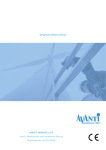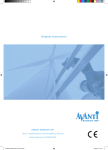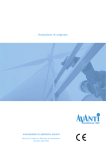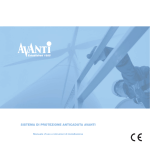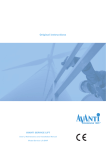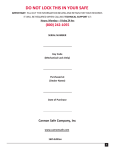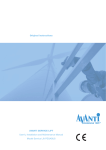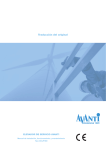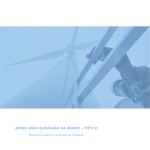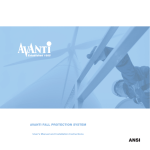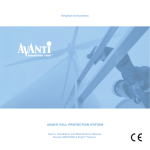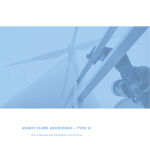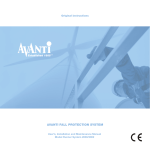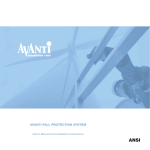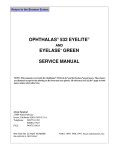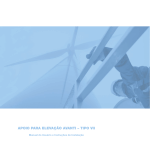Download Original - Avanti Online
Transcript
Original AVANTI SERVICE LIFT User’s, Installation and Maintenance Manual Model Service Lift DOLPHIN Date of publication: 2nd CE Edition: 11/2012 Revision 1: 20/11/12 Manufacturer: AVANTI Wind Systems A/S Høgevej 19 3400 Hillerød Denmark P: +45 4824 9024 F: +45 4824 9124 E:[email protected] I:www.avanti-online.com Sales & Service: Australia Avanti Wind Systems PTY LTD P: +61 (0) 7 3902 1445 China Avanti Wind Systems P: +86 21 5785 8811 Denmark Avanti Wind Systems A/S P: +45 4824 9024 Germany Avanti Wind Systems GmbH P: +49 (0) 41 21-7 88 85 – 0 Spain Avanti Wind Systems SL P: +34 976 149 524 UK Avanti Wind Systems Limited P: +44 0 1706 356 442 USA Avanti Wind Systems, Inc P: +1 (262) 641-9101 India Avanti Wind Systems, PL P: +91 44 6455 5911 Only trained people may use this lift. This manual must be available to staff at all times during installation, maintenance and operation. Additional copies are available from the manufacturer upon request. All measurements are indicative only and subject to change without notice. Contents Page User’s manual 1 LIMITED WARRANTY . . . . . . . . . . . . . . . . . . . . . . . . . . . . . . . . . . . . . . . . . . . . . . . . . . . . . . . . . . . 5 2CAUTIONS . . . . . . . . . . . . . . . . . . . . . . . . . . . . . . . . . . . . . . . . . . . . . . . . . . . . . . . . . . . . . . . . . . . . 6 2.1 Symbols used in this manual . . . . . . . . . . . . . . . . . . . . . . . . . . . . . . . . . . . . . . . . . . . . . . . . . . . 6 2.2 Cautions . . . . . . . . . . . . . . . . . . . . . . . . . . . . . . . . . . . . . . . . . . . . . . . . . . . . . . . . . . . . . . . . . . . 7 3Description . . . . . . . . . . . . . . . . . . . . . . . . . . . . . . . . . . . . . . . . . . . . . . . . . . . . . . . . . . . . . . . . . . . . 9 3.1 Purpose . . . . . . . . . . . . . . . . . . . . . . . . . . . . . . . . . . . . . . . . . . . . . . . . . . . . . . . . . . . . . . . . . . . . 9 3.2 Scope . . . . . . . . . . . . . . . . . . . . . . . . . . . . . . . . . . . . . . . . . . . . . . . . . . . . . . . . . . . . . . . . . . . . . 9 3.3 Technical specifications . . . . . . . . . . . . . . . . . . . . . . . . . . . . . . . . . . . . . . . . . . . . . . . . . . . . . . 10 3.4 Service lift overview . . . . . . . . . . . . . . . . . . . . . . . . . . . . . . . . . . . . . . . . . . . . . . . . . . . . . . . . . . 11 3.5 Service lift dimensions . . . . . . . . . . . . . . . . . . . . . . . . . . . . . . . . . . . . . . . . . . . . . . . . . . . . . . . . 12 3.6 Controls . . . . . . . . . . . . . . . . . . . . . . . . . . . . . . . . . . . . . . . . . . . . . . . . . . . . . . . . . . . . . . . . . . . 13 3.6.1 Main control box . . . . . . . . . . . . . . . . . . . . . . . . . . . . . . . . . . . . . . . . . . . . . . . . . . . . . . . 13 3.6.2 User control box . . . . . . . . . . . . . . . . . . . . . . . . . . . . . . . . . . . . . . . . . . . . . . . . . . . . . . . 13 3.7 Interlock control box bottom platform . . . . . . . . . . . . . . . . . . . . . . . . . . . . . . . . . . . . . . . . . . . 14 3.7.1 Main switch and ready light . . . . . . . . . . . . . . . . . . . . . . . . . . . . . . . . . . . . . . . . . . . . . . . . 14 3.7.2 Interlock switch on bottom platform . . . . . . . . . . . . . . . . . . . . . . . . . . . . . . . . . . . . . . . . 14 3.7.3 Tapped key system on top platform . . . . . . . . . . . . . . . . . . . . . . . . . . . . . . . . . . . . . . . . . 14 3.8 Service lift doors . . . . . . . . . . . . . . . . . . . . . . . . . . . . . . . . . . . . . . . . . . . . . . . . . . . . . . . . . . . 15 3.9 Top stop switch and Emergency top limit stop switch . . . . . . . . . . . . . . . . . . . . . . . . . . . . . 16 3.10 Bottom safety stop . . . . . . . . . . . . . . . . . . . . . . . . . . . . . . . . . . . . . . . . . . . . . . . . . . . . . . . . . 16 3.11 Manual descent and brake release switch . . . . . . . . . . . . . . . . . . . . . . . . . . . . . . . . . . . . . . . 17 3.12 Fall arrest device . . . . . . . . . . . . . . . . . . . . . . . . . . . . . . . . . . . . . . . . . . . . . . . . . . . . . . . . . . . . 17 3.13 Overload limiter . . . . . . . . . . . . . . . . . . . . . . . . . . . . . . . . . . . . . . . . . . . . . . . . . . . . . . . . . . . . 18 3.14 Other features . . . . . . . . . . . . . . . . . . . . . . . . . . . . . . . . . . . . . . . . . . . . . . . . . . . . . . . . . . . . . 18 4 LIFT OPERATION . . . . . . . . . . . . . . . . . . . . . . . . . . . . . . . . . . . . . . . . . . . . . . . . . . . . . . . . . . . . . . 19 4.1 Operation from inside the cabin (manual) . . . . . . . . . . . . . . . . . . . . . . . . . . . . . . . . . . . . . . . . 19 4.2 Operation from outside the cabin (automatic) . . . . . . . . . . . . . . . . . . . . . . . . . . . . . . . . . . . . 19 4.2.1 Bottom platform . . . . . . . . . . . . . . . . . . . . . . . . . . . . . . . . . . . . . . . . . . . . . . . . . . . . . . . . 19 4.2.2 Top platform . . . . . . . . . . . . . . . . . . . . . . . . . . . . . . . . . . . . . . . . . . . . . . . . . . . . . . . . . . . 19 4.3 What to do if the fall arrest device engages . . . . . . . . . . . . . . . . . . . . . . . . . . . . . . . . . . . . . . 19 4.4 Manual descent . . . . . . . . . . . . . . . . . . . . . . . . . . . . . . . . . . . . . . . . . . . . . . . . . . . . . . . . . . . . 19 5Maintenance . . . . . . . . . . . . . . . . . . . . . . . . . . . . . . . . . . . . . . . . . . . . . . . . . . . . . . . . . . . . . . . . . . 20 5.1 Maintenance planning . . . . . . . . . . . . . . . . . . . . . . . . . . . . . . . . . . . . . . . . . . . . . . . . . . . . . . . 20 5.2 Daily inspection by the supervisor . . . . . . . . . . . . . . . . . . . . . . . . . . . . . . . . . . . . . . . . . . . . . 20 5.3 Yearly inspection . . . . . . . . . . . . . . . . . . . . . . . . . . . . . . . . . . . . . . . . . . . . . . . . . . . . . . . . . . . 21 5.4 Ordering spare parts . . . . . . . . . . . . . . . . . . . . . . . . . . . . . . . . . . . . . . . . . . . . . . . . . . . . . . . . 23 6 Repair in the event of breakdown . . . . . . . . . . . . . . . . . . . . . . . . . . . . . . . . . . . . . . . . . . . . . . . . 24 7 Out of service . . . . . . . . . . . . . . . . . . . . . . . . . . . . . . . . . . . . . . . . . . . . . . . . . . . . . . . . . . . . . . . . . 25 8INSTALLATION . . . . . . . . . . . . . . . . . . . . . . . . . . . . . . . . . . . . . . . . . . . . . . . . . . . . . . . . . . . . . . . . 25 8.1 Electrical connections . . . . . . . . . . . . . . . . . . . . . . . . . . . . . . . . . . . . . . . . . . . . . . . . . . . . . . . 25 8.2 Guiding, traction and safety wires . . . . . . . . . . . . . . . . . . . . . . . . . . . . . . . . . . . . . . . . . . . . . 26 8.2.1 Top . . . . . . . . . . . . . . . . . . . . . . . . . . . . . . . . . . . . . . . . . . . . . . . . . . . . . . . . . . . . . . . . . . 26 8.2.2 Bottom platform . . . . . . . . . . . . . . . . . . . . . . . . . . . . . . . . . . . . . . . . . . . . . . . . . . . . . . . 27 8.3 Wirefix installation . . . . . . . . . . . . . . . . . . . . . . . . . . . . . . . . . . . . . . . . . . . . . . . . . . . . . . . . . . . . . 28 8.4 Danger zone sticker . . . . . . . . . . . . . . . . . . . . . . . . . . . . . . . . . . . . . . . . . . . . . . . . . . . . . . . . . . . 28 8.5 Inspection before first use . . . . . . . . . . . . . . . . . . . . . . . . . . . . . . . . . . . . . . . . . . . . . . . . . . . . . . 28 Appendix A: Regulation of overload limiter . . . . . . . . . . . . . . . . . . . . . . . . . . . . . . . . . . . . . . . . . . . 29 Appendix B: Safety measures when using AVANTI DOLPHIN lifts . . . . . . . . . . . . . . . . . . . . . . . . 30 Appendix C: Installation Checklist . . . . . . . . . . . . . . . . . . . . . . . . . . . . . . . . . . . . . . . . . . . . . . . . . . . 31 4 AVANTI Service Lift for Wind Turbines 1. Limited Warranty Avanti Wind Systems A/S warrants that commencing from the date of shipment to the Customer and continuing for a period of the longer of 365 days thereafter, or the period set forth in the standard AVANTI warranty, the Product* described in this Manual will be free from defects in material and workmanship under normal use and service when installed and operated in accordance with the provisions of this Manual. This warranty is made only to the original user of the Product. The sole and exclusive remedy and the entire liability of Avanti under this limited warranty, shall be, at the option of Avanti, a replacement of the Product (including incidental and freight charges paid by the Customer) with a similar new or reconditioned Product of equivalent value, or a refund of the purchase price if the Product is returned to Avanti, freight and insurance prepaid. The obligations of Avanti are expressly conditioned upon return of the Product in strict accordance with the return procedures of Avanti. This warranty does not apply if the Product (i) has been altered without the authorization of Avanti or its authorized representative; (ii) has not been installed, operated, repaired, or maintained in accordance with this Manual or other instructions from Avanti; (iii) has been subjected to abuse, neglect, casualty, or negligence; (iv) has been furnished by Avanti to Customer without charge; or (v) has been sold on an “AS-IS” basis. Except as specifically set forth in this Limited Warranty, ALL EXPRESS OR IMPLIED CONDITIONS, REPRESENTATIONS AND WARRANTIES, INCLUDING, BUT NOT LIMITED TO, ANY IMPLIED WARRANTY OR CONDITION OF MERCHANTABILITY, FITNESS FOR A PARTICULAR PURPOSE, NON-INFRINGEMENT, SATISFACTORY QUALITY, COURSE OF DEALING, LAW, USAGE OR TRADE PRACTICE ARE HEREBY EXCLUDED TO THE MAXIMUM EXTENT PERMITTED BY APPLICABLE LAW AND ARE EXPRESSLY DISCLAIMED BY AVANTI. IF, PURSUANT TO ANY APPLICABLE LAW, TO THE EXTENT AN IMPLIED WARRANTY CANNOT BE EXCLUDED AS PROVIDED IN THIS LIMITED WARRANTY, ANY IMPLIED WARRANTY IS LIMITED IN TIME TO THE SAME DURATION AS THE EXPRESS WARRANTY PERIOD SET FORTH ABOVE. BECAUSE SOME STATES DO NOT PERMIT LIMITATIONS ON THE DURATION OF IMPLIED WARRANTIES, THIS MAY NOT APPLY TO A GIVEN CUSTOMER. THIS LIMITED WARRANTY GIVES CUSTOMER SPECIFIC LEGAL RIGHTS, AND CUSTOMER MAY HAVE OTHER LEGAL RIGHTS UNDER APPLICABLE LAWS. This disclaimer shall apply even if the express warranty fails of its essential purpose. In any cases of dispute the English original shall be taken as authoritative. * Avanti service lift (“Product”) User’s Manual 5 2. Explanation of symbols used in this manual 2.1 Symbols used in this manual Symbol Signal word Meaning Possible injury if not observed IMMEDIATE or possibly imminent danger: Death or severe injury! Safety instructions STOP DANGER! DANGER! CAUTION! IMMEDIATE or possibly imminent danger of hazardous voltage: Death or severe injury! Potentially hazardous situation: Light injury or material damage. ATTENTION! Potentially dangerous situation: Damage to equipment or workplace IMPORTANT! Useful tips for optimum working procedure None Additional instructions ! Order 6 Reference to written specification/documentation AVANTI Service Lift for Wind Turbines 2.2 Cautions CAUTION! Avoid injury – follow all instructions! a) Installation and/or maintenance and/or operation of the service lift and its suspension may be performed only by qualified personnel, hired by the employer for the job at hand. b) The personnel must be at least 18 years of age. The staff must be familiar with the relevant accident prevention instructions and must have received proper training in these. c) Personnel is obliged to read and understand this User’s Manual. d) A copy of the User’s Manual must be handed out to the personnel and must always be available for reference. e) If more than one person is entrusted with one of the above tasks, the employer shall appoint a supervisor in charge of the operation. STOP DANGER! f) Whenever installation, ascending, and/or descending involves a danger of falling, all personnel inside the danger area must wear personal protective equipment which will prevent them from falling by means of a safety system secured to the building. g) Only fault-free suspension devices, cabin components, traction hoist equipment, fall arrest devices, original traction hoist wires and stopping devices may be used. h) Electrical connection of the system must be made in accordance with EN 60204-1. i) Prior to mounting, all parts must be tested to ensure their completeness and full functionality. j) Self-locking nuts must be used at all times, and the following must always be observed: a. The screw must extend from the nut by at least half of the thread diameter. b. The nut may not be used once it has become possible to loosen by hand! l) If any damage or faults are found during operation, or if circumstances arise which may jeopardize safety: a. Immediately interrupt the work in progress and notify the supervisor or employer! m)All tests/repairs of electrical installations may only be performed by qualified electricians. n) All repairs to the traction hoist, fall arrest device and the system’s supporting parts may be performed only by qualified fitters. o) If any supporting parts are repaired or replaced, the operational safety of the system must be tested and verified by an expert. p) Use of non-original parts, in particular use of wires other than the prescribed original traction hoist wire will render the manufacturer’s warranty void and the CE approval invalid. q) No modification, extension or reconstruction of the service lift is allowed without the manufacturer’s prior written consent. r) No warranty is provided against damage resulting from reconstruction or modification of equipment or use of non-original parts which are not approved by the manufacturer. s) Before using the lift an inspection by the authorised security organisation must be carried out. t) The lift must be inspected at least once a year by an expert that has been trained by AVANTI. The traction hoist and saftey break must be overhauled at an authorised workshop and furnished with a new certificate for every 250 hours of operation. u) The service lift may not be used by persons who are under the influence of alcohol or drugs which may jeopardize working safety. The tower owner must verify the need for third party service lift inspections with the local authority and comply with the standards specified k) Prior to mounting the suspension system, ensure that the building sections involved will be able to carry the load. User’s Manual 7 3. Description 3.1 Purpose The Service Lift described in this User’s Manual serves the following purposes: - Transportation of staff and material inside wind turbine systems. - Transportation for mounting, inspection and repairs. The service lift may be used to transport persons plus their tools and equipment to the most convenient height for performing work on the tower. 3.2 Scope The system consists of a service lift, its guiding system along the tower, its traction and safety wires made in steel, power supply system and the protective fences at landings including their interlock system. The system details are described in this manual. The service lift includes a cabin made in aluminium, a traction system, a fall arrest device, a control system and safety devices. The guiding system incorporates a set of guiding wires made in steel, the attachments to the tower and the guides on the car. The protective fences consists of aluminium structures covered with perforated sheet of different geometries depending on the landings where they are installed. The interlock systems installed on the protective fences consist of guard locking and position switches and its control system which is linked to the service lift control system. The system as a whole meets the essential health and safety requirements as required by the European Machinery directive 2006/42. The pictures and sketches on this manual may not reflect the product aesthetics, colours, arrangement precisely. This has no impact on the function or safety. 3.3 Technical specifications Service lift Cabin weight 160 Kg Service lift speed 18 m/min ± 20 % Working load limit / Nº persons (max) 240 Kg / 2 Persons Operating temperature -15ºC to +60ºC Survival temperature -25ºC to +80ºC Max. Noise level 85 dB (A) Wire attachments Shackle 2T form C with Power supply 3 Phase 400V / 690V, Traction and safety wires Diameter 8.4 mm Breaking load limit (min.) 55 kN Surface treatment HDG Mark / Feature Blue string Weight (approx.) 0.23 Kg / m Guiding wires Diameter 12 mm Breaking load limit (min.) 55 kN Surface treatment HDG Mark / Feature None Weight (approx.) 0.52 Kg / m Power cable Type 5G1.5 (400V) / 4G1.5 (690V) Weight (approx.) 0.16 Kg/m Hoist 8 AVANTI Service Lift for Wind Turbines Power 1.5 kW Amperage (max.) 400 V 4.1 A Amperage (max.) 690 V 2.3 A Working load limit 500 Kg 3.4 Service lift overview 1 16 2 3 4 5 6 7 8 9 10 11 12 13 14 15 1. Emergency Top Limit Stop Switch 7. Main Control Box 13. Bottom Sliding Door 8. Hour Counter 14. Traction & Safety Wire Inspection Window 2. Top Limit Switch 9. Anchor Point 3. Safety Wire 15. Bottom Safety Stop 10. Top Sliding Door 4. Traction Wire 11. External Controls 16. Traction Hoist And Fall Arrest Device 5. Guides Wires 12. User Control Box 6. Cabin Light User’s Manual 9 3.5 Service lift dimensions 10 AVANTI Service Lift for Wind Turbines 3.6Controls 3.6.1 Main control box Emergency top limit stop switch Safety gripping device switch No power descent buzzer Top stop switch Door interlock switch Bottom stop switch Manual descent switch User control box connector Light Hour counter Green light (Ready) On if the lift is ready to use, no safety precautions activated 3.6.2 User control box EMERGENCY STOP Press to interrupt any control function Pull to reset the control after necessary verifications ON/OFF TRAPPED KEY SWITCH Turn the key to ON to operate the lift. The key will be trapped and can’t be removed until it is switched OFF Remove the key and use it to open the trapped key lock on the top gallery UP/DOWN BUTTONS (Manual / Automatic - Send) Push the automatic “UP” or “DOWN” button, to send the lift all the way to the top or bottom of the tower. Automatic DOWN is only possible from the top platform and Automatic UP is only possible from the bottom platform. UP / DOWN Manual UP / DOWN Automatic OVERRIDE BOTTOM LIMIT SWITCH OVERLOAD BUZZER Sounds when the cabin is overloaded User’s Manual 11 3.7 Interlock control box bottom platform 3.7.3 Trapped key system on top platform The interlock control box is installed at the bottom platform gallery. The top platform gallery door is fitted with a trapped key lock keeping the door locked while the service lift is not at the top platform. The door can be unlocked by using the trapped key on the user control box and opening the trapped key lock. The key will get trapped until the door is closed and locked again. 3.7.1 Main switch and ready light The interlock control box has a main switch. Turn the switch to the OFF position to cut the power to the service lift. The main switch must be set to OFF when the lift is not in use, when leaving the wind turbine and while the wind turbine is running. It must be set to OFF before starting an electrical generator. Trapped key lock Trapped key lock actuator Main switch Green light (Ready) Power inlet (from WTG) Power outlet (to lift) Connector Interlock switch Guard locking switch actuator Guard locking switch Guard locking switch emergency release button 3.7.2 Interlock switch on bottom platform The bottom platform gallery door is fitted with an interlock switch keeping the door locked while the service lift is not at the bottom platform. The door is unlocked when the service lift is at the bottom platform with the lift detection switch activated. The green light is ON when the door is closed. 12 AVANTI Service Lift for Wind Turbines Lift detection switch 3.8 Service lift doors The top sliding door is closed by pushing the actuator into the door switch. The control will be interrupted if the door is not closed properly or opened while the lift is moving. The bottom sliding door is closed by pushing the actuator into the guard locking switch. The guard locking switch is automatically unlocked when the cabin is located on the top or the bottom platform. In case of power cut, need of evacuation between platforms or need to access intermediate platforms, the guard locking switch can be unlocked by pushing its emergency release red button. To reach the emergency release red button from inside the cabin the following actions are required: - Remove the lock between the top and bottom sliding door by pushing it down - Open the top sliding door - Push the emergency release red button and open the bottom sliding door at the same time. Top sliding door actuator Top sliding door switch Bottom sliding guard locking switch Lock Sliding door Bottom sliding guard locking actuator Emergency release red button bottom sliding door User’s Manual 13 3.9 Top stop switch and Emergency top limit stop switch Top stop switch Emergency top limit stop switch At the top of the cabin a top limit stop switch will stop upward travel when activated. Downward travel will still be possible. A top stop disc activating the top stop switch is installed below the lifting wire attachment. Emergency top limit stop switch interrupts the control if the top limit stop switch fails. Manual downward travel is possible. ! ATTENTION! When the top limit stop switch is engaged, press the DOWN button until the top limit stop switch is released CAUTION! Do not use the service lift until the top limit stop switch fault has been rectified. 3.10 Bottom safety stop The bottom safety stop switch stops downward travel if the service lift: • encounters an obstacle • touches the ground Upward travel will be possible, for instance to remove the obstacle. In order to put the service lift on the ground, the operation of the contact plate can be bypassed with the override bottom limit stop switch in the user control box. To do so, turn the override bottom limit stop switch key while pressing the DOWN button. CAUTION! Release the DOWN button as soon as the rubber feet hit the floor. Otherwise the lift or the installation may get damaged 14 AVANTI Service Lift for Wind Turbines Bottom safety stop 3.11 Manual descent and brake release switch The service lift is delivered with a lever allowing manual release of the electromagnetic motor brake. Once the motor brake is released, the service lift travels down with a controlled speed limited by a centrifugal brake installed between the motor shaft and the gear box. When the brake release lever is pushed upwards, the brake release switch is activated. The brake release switch will interrupt any control function. The manual descent buzzer will sound while the service lift travels down. Fall arrest device Lever extension tube Brake release switch Manual descent actuator PULL TO UNLOCK PUSH UPWARDS TO PERFORM MANUAL DESCENT PULL TO LOCK Overspeed unlocking knob (black) Overspeed locking knob (red) 3.12 Fall arrest device The service lift is equipped with a fall arrest device which will be triggered in case of an overspeed condition. The speed of the safety wire passing through the device is continuously monitored, and the jaws are automatically closed in the event of sudden excessive speed. Manual descent actuator holder The fall arrest device can also be engaged manually in an emergency by pulling downwards the red locking knob on the back of the lift, this will turn its emergency stop lever counter clockwise. To release the fall arrest device stop lever, the black unlocking knob on the back part of the lift has to be pulled downwards. This protects the lift in case of traction wire or if its attachment breaks from hoist failures. User’s Manual 15 3.13 Overload limiter DANGER! Attempting to go up in an overloaded lift is prohibited! A lifting force limiter is built into the wire traction system and will prevent upward travel in the event of overload. In case of overload, the lift’s upward travel will be blocked, and a buzzer will sound in the user control box. The buzzer will stop only when the cause of the overload has been removed. Possible reasons for activation of the limiter: • The service lift is overloaded. • The service lift encounters an obstacle during upward travel. Operator intervention: • Reduce the load to below the overload limit. • Lower the lift until it is free of the obstacle and remove the obstacle before using the lift again 3.14 Other features Anchor points The service lift is equipped with two anchor points inside the cabin. During operation personnel shall hook themselves up to the anchor points inside the cabin. In case of need of evacuation, the evacuation procedure must be observed. Light The service lift is equipped with a light inside the cabin. The light is on when the lift is powered. 16 AVANTI Service Lift for Wind Turbines STOP On entering and starting the lift, the buzzer may sound briefly. This is due to temporary load peaks occurring as the lift takes off. The control box is designed not to activate the buzzer or stop the lift because of peak loads caused by the cabin swinging. 4. Lift Operation 4.1 Operation from inside the cabin (manual) 4.3 What to do if the fall arrest device engages A. Turn the main switch on the interlock control box to the ON position B. Enter the service lift and close the bottom / top gallery door C. Turn the trapped key switch ON D. To go up or down, push and hold the UP or DOWN button as needed If the fall arrest device engages simply disengage it by pulling downwards the black knob on the back of the lift until the fall arrest device is unlocked. However, this is not possible if the safety wire is under tension. If this is the case: A. Remove the load on the safety wire by pushing the UP button taking the lift upwards a few centimetres. B. Manually open the fall arrest device by pulling downwards the black knob until the safety gripping device is unlocked. In case of no power and the fall arrest device is locked with the safety wire under tension evacuate the lift according to the evacuation procedure. 4.2 Operation from outside the cabin (automatic) Transportation of people is forbidden if the operation is controlled from outside the service lift. Automatic function is only possible from top platform to bottom platform and vice versa. 4.2.1 Bottom platform 4.4 Manual descent A. Turn the main switch on the interlock control box to the ON position B. Insert the trapped key inside the switch on the user control box and turn it ON C. Close the service lift door D. Close the top gallery door E. Press the UP button using the send tool In case of power failure, a controlled descent without power can be performed. To do so: - Verify that the fall arrest device is unlocked - Check that there are no obstacles or persons in the way - Take the manual descent actuator from its holder and insert it on the lever extension tube - Push the manual descent actuator upwards. The service lift will start travelling down and a buzzer will sound - To stop the manual descent, stop pushing upwards 4.2.2 Top platform A. Close the top gallery door B. Insert the trapped key inside the switch on the cabin user control box and turn it ON C. Close the service lift door D. Press the DOWN button STOP WARNING! In the event of traction wire breaks or hoist fails, evacuate personnel from the service lift. CAUTION! The safety wire suspension and the attachment between the fall arrest device and the service lift are exposed to dynamic loads when a fall is blocked. When the service lift has returned to ground level, test the fall arrest device function. Replace any defective fall arrest device components and return them for repair to the manufacturer. User’s Manual 17 5.Maintenance 5.1 Maintenance planning Time (Performance) Component Daily (Supervisor) Operating area and service lift visual inspection Service lift controls and safety devices Annually (Expert) Wires Electrical cable Annually (Expert) Entire system Annually, however at least every 250 hours of operation (Expert) Traction hoist Annually (Expert) Fall arrest device 5.2 Daily inspection by the supervisor Operating area: Ensure that there are no obstacles within the service lift’s operating area which may obstruct the travel of the cabin or cause the cabin to hit the ground. Service lift: a) Check that the service lift components are mounted in accordance with the specifications and without any noticeable defects or missing components b) Check that the traction and safety wires are not damaged or jammed c) Check that the safety devices are in place and working: a. Main switch: Turn the main switch on the interlock control box to the OFF position. The green light must be OFF. The service lift must not run. Turn it ON, the light shall be ON. b. Green light (Ready) – Service lift: Close and lock the bottom platform gallery door and the service lift door. Turn the trapped key to the ON position. The green light must be ON. It should not be possible to remove the trapped key unless it is switched OFF again. c. Emergency stop: Press the emergency stop button on the user control box. The service lift should not move UP / DOWN. Release the emergency stop and drive the lift UP approximately 1 meter. 18 AVANTI Service Lift for Wind Turbines d. Service lift door: Pull the door to open. The door should not open. Unlock the top sliding door from the bottom sliding door and pull to open. The top sliding door should open, the green light must be OFF and the lift must not move UP / DOWN. Close the top sliding door and apply the lock to the bottom sliding door e. Activate the fall arrest device by pulling the red locking knob. Press the DOWN button of the User control box. The service lift should not move down. Press the Up button of the User control box. The service lift should move UP. Unlock the fall arrest device by pulling the black unlocking knob. f. Perform a manual descent test for some centimetres. The lift should move down and the buzzer should sound. g. Drive the service lift down until the bottom safety stop hits the ground. The service lift should stop before the rubber feet hit the platform. The service lift door and the gallery door should be unlocked. d) When the lift is at the top landing, check the wire attachments. WARNING! If any faults occur during work, - stop working, - if required secure the workplace and - rectify the fault! DANGER! Make sure that nobody is exposed to danger below the service lift, for instance from falling parts. Cabin control from outside of the cabinAutomatic: Service lift cabin: Inspect the cabin structure, joints, attachments and accessories. STOP The automatic mode function is only available from the control buttons outside of the cabin at the bottom platform and top platform. It shall be checked as follows: a) Press the UP button on the control box. The lift should travel upwards. b) Press the EMERGENCY STOP on the control box. The lift stops. c) Pull the EMERGENCY STOP button and press the DOWN button. The service lift should travel downwards until the bottom stop switch engages. Traction hoist: The traction hoist is largely maintenance free. Clean only when very dirty. During cleaning always ensure sufficient air supply. Annual test (only by authorized persons): a) Ensure that no visual defects have appeared. b) Test manual descent function. c) Test speed and current should be like measured on the first hoist test. d) Check that sound and behaviour are normal 5.3 Yearly inspection Have the entire system tested by an AVANTI trained expert at least once annuallly, especially the traction hoist and the fall arrest device. However, it may be required more frequently depending on use and the conditions of use and operation. The traction hoist and fall arrest device must be overhauled at AVANTI workshops and furnished with new certificate for every 250 hours of operation. Time counter is found in the power cabinet. ! ATTENTION! If fall arrest device has engaged, an expert must verify the safety of the fall arrest device, the wire, and wire attachment. The tower owner must ensure that the results of all annual and extraordinary testing are logged User’s Manual 19 Fall arrest device: Annual test: The fall arrest device is largely maintenance free. Clean only when very dirty. Keep free from dirt and lubricate often. Using too much oil will not harm the equipment or the gripping function. a) Check and replace the respective wire(s) if one of the following defects are found: - 8 wire strand breaks or more on a wire length corresponding to 30 times the wire diameter - Severe corrosion on the surface or inside. - Heat damage, evident by the wire colour. - Reduction of the wire diameter by 5% or more compared to the nominal wire diameter - Damage on the wire surface – See figures below for common examples of wire damage. Annual test (only by authorized persons): a) Test the fall arrest device stop lever by pulling the red locking knob. b) Test the fall arrest device stop lever reset, by pulling the black unlocking knob. c) Release safety wire bottom attachment in the tower and pull the safety wire with a jerk. The overspeed device should trigger the fall arrest device automatically. d) Ensure that no visual defects have appeared These examples do not, however, replace the relevant provisions laid down by ISO 4309! b) Check and ensure that all wires are mounted at the top and ground level as specified in this manual Wire/cables: Always keep the wires clean and slightly greasy. Ropes must be greased regularly with standard multipurpose grease. Greases containing disulphide must not be used. Wire diameter Wire strap/loop, which cannot be unwound Loop knot forming when a wire loop is pulled tight Bends resulting from inappropriate treatment (e.g. securing the load with the wire) Damage resulting from crushing, squeezing, running over, etc. Wire bags Loop formation 20 AVANTI Service Lift for Wind Turbines Wire strand breaks Repairs: Repairs to traction hoist equipment must ONLY be performed by AVANTI, and only using original spare parts. If the gearbox oil needs to be replaced, use one of the lubricants specified below, corresponding to the temperature range in which the traction hoist equipment is used. Amount required: 1,5 l Traction hoist: M500 / M508 Specification: MSHC 632 VG320 Each oil has to be verified by AVANTI 5.4 Ordering spare parts Only use original parts. Spare part lists are available from AVANTI. Please indicate lift model when requesting a spare part list. Overload check and adjustment Annual test: Test switches as specified in section 8.1.1 of the traction hoist manual (perform overload test as specified on section 8.1.1 e of the Traction Hoist Manual). Verify completeness and legibility of all rating plates and information signs. Replace missing or illegible plates and signs! User’s Manual 21 6. Repair in the event of breakdown 1.All tests and repairs to the electronic components should be performed by an authorised electrician only! The wiring diagram is placed in the traction hoist’s power cabinet. Breakdown The service lift will neither go up nor down! 2.Repairs to the traction hoist, the fall arrest device and to the system’s supporting components should be performed by qualified fitters only! Cause STOP Solution DANGER! Attempting to use the lift will jeopardize work safety A1The fixed EMERGENCY STOP button has been activated. Reset the button in question by pulling or turning it A2Wire loop on traction hoist. Damaged or defective wire or wire outlet causes problems. Stop work immediately! Ask the supplier or manufacturer for help. A3The fall arrest device is holding the service lift on the safety wire. a) Lift wire breakage b) Hoist failure A4The service lift is stuck on an obstacle. A5Power failure a) Main switch is OFF b) Grid voltage interrupted c) Supply between grid connection and control interrupted A6Limit stop switch functions a) Emergency top limit stop switch was activated. b) Top sliding door is open c) Manual descent switch is activated A7Protection switch on overheating a) A phase is missing b) Motor is not cooling c) Voltage too high/low a) + b)Evacuate the service lift Carefully remove the obstacle. Test the operational safety of affected tower sections. Inform the supervisor. a) Turn the main switch ON b) Find the cause and wait for the power to return. c) Test and if necessary repair the supply cable, guide wires, fuses, and/or wiring from the control box a) Manually take the lift down until the limit stop switch is released. b) Close the top sliding door c) Adjust manual descent switch so that it is not involuntarily activated a) Test/repair fuses, supply and connection. b) Clean the hood. c) Measure voltage and power consumption on the loaded motor. If voltage deviates from specifications, use cable with increased dimensions. A8Brake does not open (no click on on/off) a)Supply, braking coil or rectifier defective. b) Braking rotor closes. a)Have an electrician test, repair/replace the supply, braking coil and rectifier. b) Return traction hoist for repair. A9 The trapped key is not present or the trapped key switch is in the OFF position. Insert the key and turn it to the ON position A10 The Guard Locking System (guard locking switch and interlock control box) are defective. Test / Repair defective component 22 AVANTI Service Lift for Wind Turbines Breakdown Service lift goes down but not up Motor hums loudly or wire ropes squeak, but the lift can go both up and down. Cause Solution B1The service lift is stuck on an obstacle. Carefully move the service lift downwards and remove the obstacle. Test the operational safety of affected platform components. Inform the supervisor. B2Overload - Buzzer sounds in the connection cabinet. Test and possibly reduce load until buzzer stops. B3Top stop switch: a) Top stop switch is defective or not connected. b) Top stop switch is activated. a) Test the top stop switch connection/ function. Replace it if necessary. b) Move lift down until the top stop switch is released. B4A phase is missing Test fuses and power supply. B5Fault in UP control circuit Test and possibly repair connections, wiring and relays. C1Wire ropes dirty If possible, immediately replace the traction hoist and return it for test/repair at AVANTI. WARNING! Further use of lift may result in damage to the wire traction. User’s Manual 23 Breakdown Cause Service lift will go up but not down! D1The service lift has encountered or is stuck on an obstacle. D2The fall arrest device is holding the service lift on the wire. a) Excessive hoist speed b) Too low release speed on fall arrest device. Solution Carefully take the service lift up and remove the obstacle. Test the operational safety of affected platform components. Inform the supervisor. a) + b) Take the service lift upwards to relieve the safety wire. Open the fall arrest device by pressing the handle, and test its function. Functional test when the lift is back on the ground: Replace the hoist and fall arrest device and return them for testing. DANGER! STOP A defective fall arrest device will threaten the safety of the service lift! Replace immediately! D3Fault in down controller circuit Insert brake lever into the traction hoist and lower lift manually. Test, and if necessary have connections, wiring, and relays repaired. Button lamp not lit although operation is normal E The lamp is defective Have an electrician replace it. Hoist goes down when up button is pressed and down when down button is pressed F Two phases changed in the supply Have an electrician switch the 2 phases in the plug If these steps do not identify the cause and rectify the fault: Consult a qualified electrician or contact the manufacturer. 24 AVANTI Service Lift for Wind Turbines 7. Out of service a) Securing the service lift: Bring the service lift all the way down, until the bottom stop switch stops the cabin. 8. Installation b) Turn off the main switch to prevent inadvertent operation of the lift: Turn the main switch to the OFF position – power supply is now interrupted. Mark the lift “OUT OF SERVICE” and padlock as necessary. Contact the service technician for repair. 8.1 Electrical connections DANGER! Before doing any connection, disconnect any power supply to the service lift and the fence interlock system The electrical connection of the traction hoist must be made in accordance with EN 60204-1. The power supply must be protected by a fuse and against indirect contacts according to local regulations. Verify that the rated grid and motor voltages are identical. Interlock bottom platform - Install the interlock control box on the bottom platform gallery - Install the guard locking switch and its actuator on the gallery door using the supplied hardware - Install the lift detection switch on its bracket on the bottom gallery toeboard and connect to the socket on the interlock control box. - Connect the power cable power inlet plug on the cable bin to the interlock control box outlet Cable bin installation - Hang the cable collect bin underneath the power cable hole of the bottom platform using the straps supplied. Attach the straps on the holes. - Cut the transport strips and tape holding the cable inside the bin and connect the cable stocking to the eyebolt underneath the service lift floor - Connect the power cable outlet socket to the service lift inlet plug attaching the cable to the cabin with cable ties. Tensioning system Power cable outlet socket Spring safety wire Cable stocking Cable collect bin suspension straps Cable collect bin Power cable inlet plug Counterweight traction wire User’s Manual 25 8.2 Guiding, traction and safety wires 8.2.1Top Guiding, traction and safety wires are attached to the suspension beam on the available holes. To install them on the suspension beam: 1) Mount the guiding wires (12 mm) and the traction and safety wires (8 mm) using the shackles supplied for the suspension beam at the top of the tower, with the guide wire outermost on either side. ! STOP 2) Fit the nuts and bolts on the shackles. Lock with cotters. 3) Fit the top stop disc on the traction wire leaving at least 200 mm between disc and shackle. Adjust the final position during first run so that the service lift is levelled with the top platform when it stops. 4) Uncoil all wires to the bottom of the tower ATTENTION! All wires must be evenly uncoiled to prevent looping. WARNING! Do not pull wire over edges. Guiding wires Traction wire Safety wire Top stop disc Bottom platform hole arrangement 26 AVANTI Service Lift for Wind Turbines 8.2.2 Bottom platform Installation of guiding wires on the bottom platform is done as follows: 1) Feed the guide wires through the guide wires on the service lift and the holes in the platform 2) Fit the correct number of wire fixes on the wire and feed through the wire guides. The wire fixes are fitted during the first run 3) Pull the guide wire through the platform and fasten it with the tensioning system 4) Pre-tighten the wires using the tensioning system 5) Final tightening must be performed after the first run a. Feed the wires through the tensioning system b. Attach the wire to the tensioning system using the wire grips and make a mark on the wire before starting tensioning. c. After the first run tightens, tension the wires to 4000 N (the wire stretches approximately 50 N/ mm) using the supplied nut. Use the second nut to lock the assembly. Installation of traction and safety wires on the service lift is done as follows: 1) Open the wire inspection on the back of the service lift 2) Remove protection guard above rollers 3) Feed the wires through the rollers For the traction wire: a. Feed the wire through the roof into the traction hoist’s wire inlet opening b. Push the UP button on the cabin operation control (manual control from inside the cabin) and feed wire through until the traction hoist starts pulling. Ensure that the wire can exit without obstruction! For the safety wire: a. Feed the wire through the roof into the fall arrest device’s wire inlet opening b. Pull the wire through the fall arrest device while pushing turning the release lever clockwise 4) Continue feeding the wire around the pulleys to the back of the lift 5) Feed the wire through the guide bushing 6) Feed the wire through the platform holes 7) Secure the 11 kg counterweight on the traction wire at least 400 mm below the bottom platform. Wire is coiled with at least 3 strips. The counterweight and excess cable must be able to rotate freely 8) Feed the compression spring through the safety wire. Pretension the safety wire by hand as much as possible before fastening the wire locks. Cut the mounting strips keeping the spring compressed. This will apply a tension of approximately 40 Kg to the safety wire. Traction wire rope Safety wire rope User’s Manual 27 8.3 Wirefix installation 8.5 Inspection before first use Wirefixes are installed and adjusted during the first run so that the centres of the wirefixes are in the centre of the service lift wireguides. Wirefixes must be installed on each platform and as required along the tower to improve guiding to avoid collision with tower elements. Use the oblong holes on the wirefix brackets to align and adjust the wirefix position. An officially recognised expert must: Wirefix bracket Wirefix a) Inspect the service lift components, safety devices and functions as specified in this manual following the inspection check list. b) Carry out a test run with the maximum rated load. c) Verify that the power cable coils and coils correctly. d) Perform an overload test. Adjust as necessary. Check the traction hoist manual for adjusting instructions for the overload limiter. e) Test the guide, drive and safety wires as well as the top and bottom wire fastenings at full length as part of the initial test run. f) Check the adjustment of the wirefix along the tower g) Test the fall arrest gripping device (see the maintenance section) Wireguide STOP 8.4 Danger zone sticker Mount the “Danger Zone” sticker in the front door of the bottom platform gallery. Make sure that the gallery plate is clean and dry before attaching the sticker. NOTE! The results from this test must be recorded in writing and saved for later reference (“Check list”). 28 AVANTI Service Lift for Wind Turbines WARNING! DANGER ZONE! Do not enter during lift operation! STOP ACHTUNG! GEFAHRENBEREICH! Wärend des Betriebes nicht betreten! Appendix A: Regulation of overload limiter Verification and/or adjustment of the overload device on the service lift can only be done by a qualified person, who must have been instructed by AVANTI to perform this task. CAUTION! Avoid injury by strictly following the instructions! NOTE! Before driving to the service lift make sure that the service lift can be loaded with the permissible test load. Required tools/material: - Security TX40 - Ballast for applying the test load To modify the lifting load limit: 1) Insert the overload adjustment tool in the adjustment screw through the hole 2) Turn the tool clockwise to increase the lifting load limit 3) Turn the tool counterclockwise to decrease the lifting load limit Note: one turn on the adjustment screw represents a change of approximately 40 Kg on the lifting load limit. Service Lift Setup load travel distance (Kg) Test load (Kg) 51 to 60 m 295 355 60 to 70 m 300 360 71 to 80 m 305 365 81 to 90 m 310 370 91 to 100 m 315 375 101 to 110 m 320 380 111 to 120 m 325 385 121 to 130 m 330 390 131 to 140 m 335 395 141 to 150 m 340 400 To adjust the lifting load limit proceed as follows: a) Place the service lift on the lowest travel point b) Apply the Setup load from the table depending on the tower height. c) Push the UP button. c.i) If the lift cannot go UP go to d) c.ii) If the lift can go UP, decrease the lifting load limit and go to b) d) Remove 20 Kg from the Setup load and push the UP button d.i) If the lift can go UP, go to e) d.ii) If the lift cannot go UP, increase the lifting load limit and go to b) e) Apply the Test load from the table depending on the tower height. e.i) If the lift cannot go UP, go to f) e.ii) If the lift can go UP, decrease the lifting load limit, review the values of the loads used and go to b) f) The overload is correctly set. Perform a full run to the top and check that the overload limiter is not activated. If it is, review the values of the loads used and return to b) g) Fill in the “Annual inspection check list” Installation Manual 29 Appendix B: Safety measures when using AVANTI DOLPHIN lifts General: The Service Lift/Work Cage is only to be used by personnel who has received instructions in operating the Lift/Cage in all predictable situations. These instructions can only be given by a person with the proper knowledge e.g. Avanti Trainer or Trainer approved by AVANTI. The following precautions and procedures are to be followed during operation of, and if the Lift/Cage stops and the manual emergency descend cannot be performed. Operating the Lift/Cage: Anyone going in the Lift/Cage must at all times wear PPE (safety helmet, full body harness, shock absorber, lanyard and runner or slider fitting the fall protection system on the ladder). Evacuation of personnel from the Lift/Cage is only necessary in very extreme situations. If necessary AVANTI recommends the following procedures: 1. User(s) attaches shock absorber to the yellow anchor point(s) and slide the door into open position (see fig. 1) 2. User(s) climbs on to the ladder and establishes suitable safety in the ladder area. After safe anchoring in the ladder area, user releases his anchor in the Cabin/Cage (see fig. 2). Fig. 1 Fig. 2 3. User(s) climbs to the other side of the ladder with proper safety technique and attaches runner/slider to the present fall protection system on the ladder (see fig. 3). User(s) can now climb safely up or down the ladder (see fig. 4). Fig. 3 Fig. 4 Rescue of lift from the ladder is only necessary in very extreme situations. If necessary AVANTI recommends the following procedures: 1. User(s) is on the work side of the ladder with attached runner/slider to the present fall protection system on the ladder and at the same level as the Service Lift/Work Cage (see fig. 5). 3. User(s) climbs to the other side of the ladder using the proper safety technique, slide the door into open position and attaches the other shock absorber hook to the yellow point inside the Lift/Cage (see fig. 7). 2. User(s) attaches one of the shock absorber hooks to the yellow anchor point which is in the ladder stile. After safe anchoring in the ladder area, the runner is released from the Safety Rail (see fig. 6). 4. User(s) transfers to the Lift/Cage using the proper technique and attaches the shock absorber properly. When user is located in safe area, he can release his anchor from the Safety Ladder (see fig. 8). Fig. 5 Fig. 6 30 AVANTI Service Lift for Wind Turbines Fig. 7 Fig. 8 Australia Avanti Wind Systems PTY LTD Unit 15 / 160 Lytton Road Morningside 4170 · Queensland P: +61 (0) 7 3902 1445 · F: +61 (0)7 3902 1252 China Avanti Wind Systems Building 4 · No, 518 Gangde Road · XiaokunshanTown Songjiang District · 201614 Shanghai P: +86 21 5785 8811 · F: +86 21 5785 8815 Denmark Avanti Wind Systems A/S Høgevej 17-19 · 3400 Hillerød · Denmark P: +45 4824 9024 · F: +45 4824 9124 Germany Avanti Wind Systems GmbH Max-Planck-Str. 10 25335 Elmshorn P: +49 (0) 41 21-7 88 85 – 0 · F: +49 (0) 41 21- 7 88 85-20 Spain Avanti Wind Systems SL · Poligono Industrial Centrovia Calle Los Angeles No 88 nave 1 · 50198 La Muela P: +34 976 149524 · F: +34 976 149508 45540046 – Dolphin Lift manual, EN 2nd CE Edition: December 2012 Revision 1: 20/11/12 UK Avanti Wind Systems Limited Caldershaw Business Centre · Unit 29 Ings Lane · Rochdale · OL12 7LQ P: +44 0 1706 356 442 USA Avanti Wind Systems, Inc. 5150 S. Towne Drive · New Berlin · Wisconsin 53151 P: +1 (262) 641-9101 · F: +1 (262) 641-9161 India Avanti Wind Systems India Private Ltd Indus Valley’s Logistic Park · Unit 3 · Warehouse No. G-2 Ground Floor · Vellala Street · Mel Aiyanambakkam Chennai 600095 · Tamil Nadu P: +91 44 6455 5911 I: www.avanti-online.com · E: [email protected]































